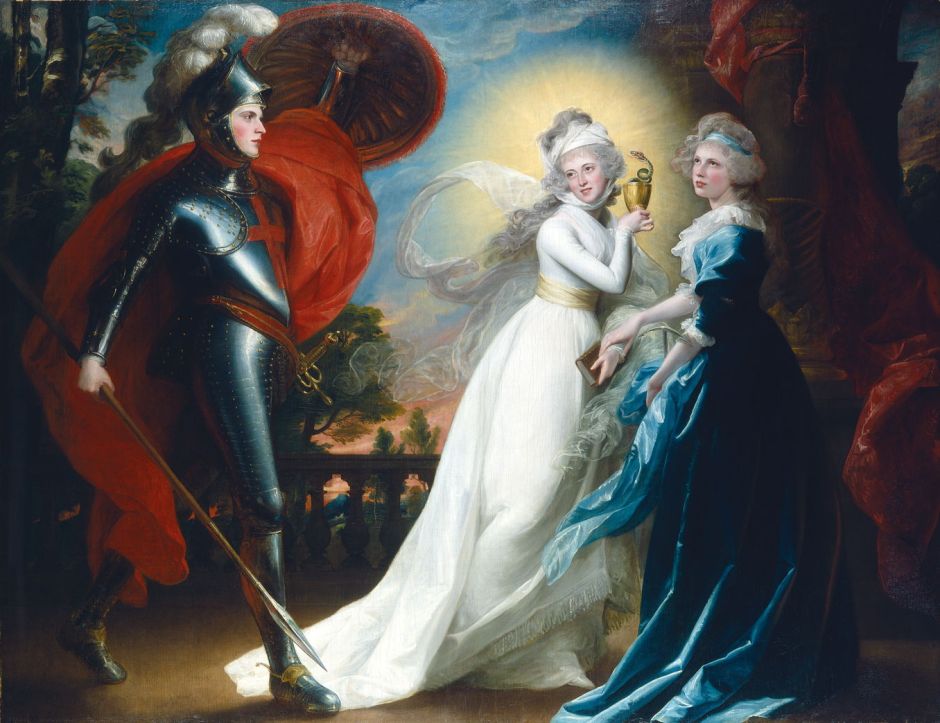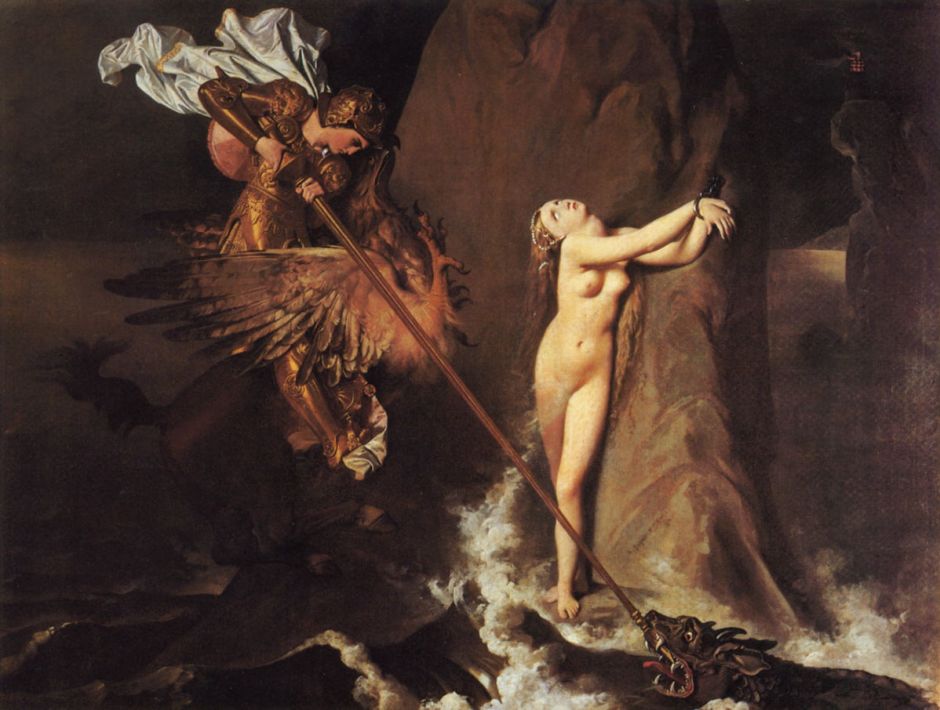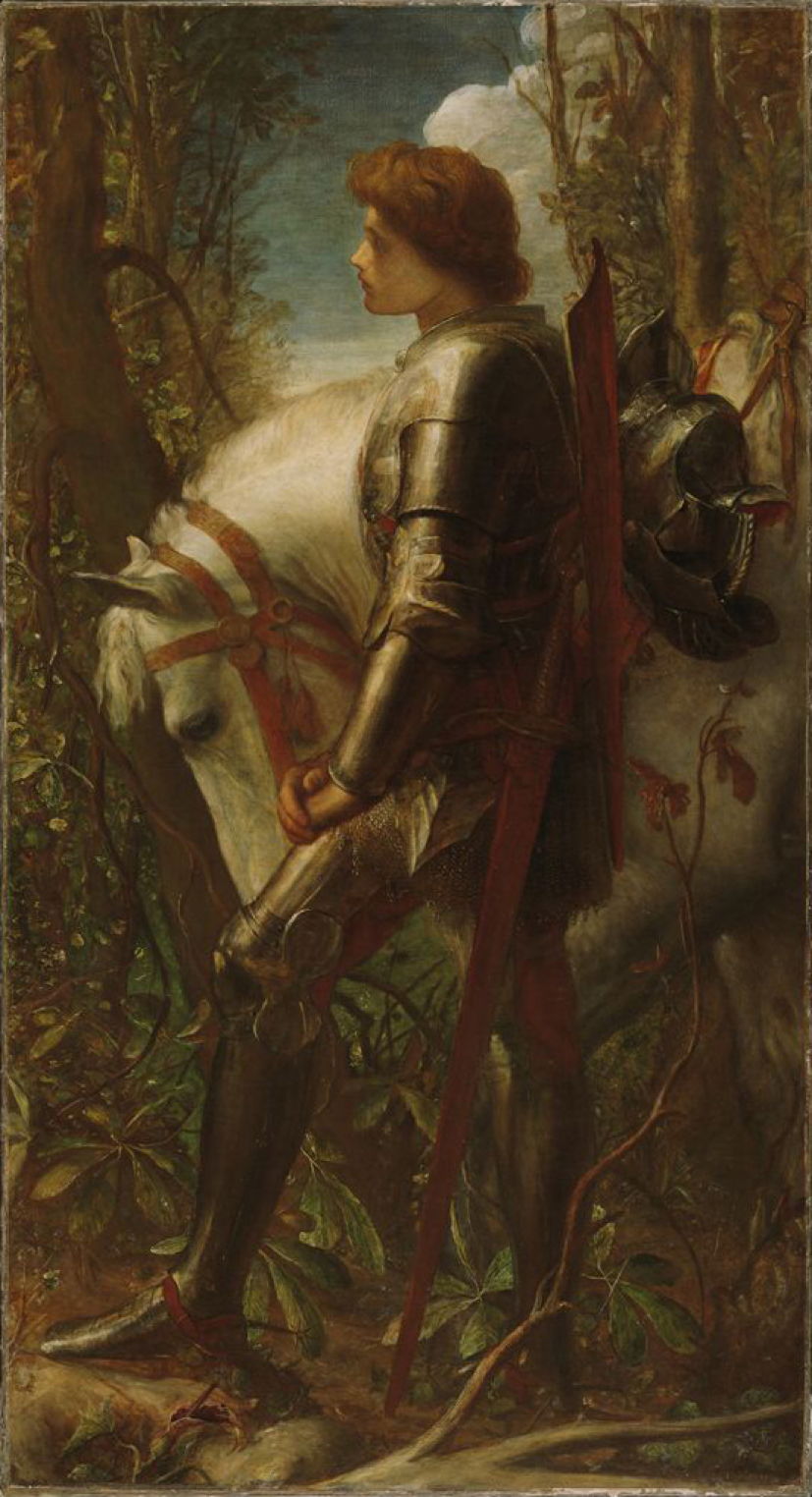The great majority of European narrative paintings draw on classical myth and Christian religious books for their literary sources. This weekend I look at those which instead rely on more recent legends from the Middle Ages, about knights and chivalry. These tell of warrior saints, characters from the first great fictional epics of the Renaissance, and Arthurian legend.
Stories of errant knights in shining armour who came to the rescue of beautiful damsels and vanquished foes and fire-breathing dragons may have flourished in the nineteenth century, but had earlier origins.

Raphael’s Saint George and the Dragon from about 1502-03 is thought to have formed a diptych with its companion piece Saint Michael and the Demon. Here Raphael combines all the key elements to tell this well-known legend: the knightly Saint George is about to deliver the fatal blow to the fearsome dragon, with the Princess keeping a safe distance. Under the saint’s horse are the shattered remains of a jousting lance.

Lucas Cranach the Younger sets The Conversion of Saul (1549) in mediaeval northern Europe, with Paul and his party riding knightly chargers in their armour. Paul’s horse has fallen to the ground, with Paul still in the saddle rather than prostrate on the ground. Paul holds his hands up and looks to the heavens, where the figure of Christ is seen in a break in the clouds at the top left corner.

Nicolas Poussin was among several artists who painted episodes from the great epics of chivalry, in this case Torquato Tasso’s Jerusalem Delivered (1581) based on the First Crusade. In Poussin’s Rinaldo and Armida from about 1630 the Saracen sorceress Armida is intent on murdering the Christian knight Rinaldo with her dagger, but falls in love with him instead. Poussin’s knight still looks fresh from his previous role serving the Roman Empire, with his sandals and boxer shorts.

John Singleton Copley’s The Red Cross Knight from 1793 shows a scene from the first book of Edmund Spenser’s allegoric epic The Faerie Queene from 1590.

At first sight, JAD Ingres’ painting of Roger (Ruggiero) Rescuing Angelica from 1819 might appear to tell the classical myth of Perseus and Andromeda, but in fact it’s one of the many swashbuckling adventures from Ariosto’s Orlando Furioso from 1516. The knight is flying on an eagle-like hippogriff rather than Pegasus, and the storyline is modified from the classical myth to fit this epic of chivalry.

In 1822-27, the German painter Julius Schnorr von Carolsfeld filled rooms in the Casa Massimo in Rome with frescoes of scenes from Orlando Furioso. This is a detail from one wall showing combat between Christian and Saracen knights.

The crusades presented Carl Friedrich Lessing with an ideal combination of mediaeval history, romance, and chivalry. In The Return of the Crusader from 1835, he shows a lone knight in full armour dozing as his horse plods its way up a path from the coast. Although his armour is still shiny, a tattered battle pennant hangs limply from his lance. This is based on a Romantic poem by the German writer Karl Leberecht Immermann (1796-1840).

The following year, Lessing continued the theme of crusading with Crusader on Watch in the Mountains (1836), shown here as a monochrome image of a full-colour painting, probably an oil study for a more finished work. A similarly bearded knight walks with his horse on an exposed mountain ridge. He is now wrapped in a long cloak, and embracing his lance.
By the middle of the nineteenth century Arthurian legend had become popular in Britain, thanks in part to republication of Thomas Malory’s compilation in Le Morte d’Arthur dating from 1485.

One of the first nineteenth century artists to respond to this rekindling of interest was the Scottish painter William Dyce. This watercolour was the study for a fresco for the Queen’s Robing Room in the Palace of Westminster (Houses of Parliament).
It shows a melée of knights of the Round Table paying tribute to King Arthur and Queen Guinevere (at the right), as those knights prepare to depart on their quest for the Holy Grail, the legendary chalice used by Christ at the Last Supper before his crucifixion, or possibly a cup used by Joseph of Arimathea to collect Christ’s blood. It is perhaps the Arthurian equivalent of Frith’s Derby Day.

George Frederic Watts’ Sir Galahad from 1860-62 was painted when the Pre-Raphaelite movement had further popularised these legends.

In keeping with the ideals of the Pre-Raphaelite movement, Philip Hermogenes Calderon painted several elaborate mediaeval scenes, of which Home After Victory (1867) is probably his finest. Contemporary notes report that this shows a knight returning to the home of his father, wife, and family.

William Etty’s painting of a scene from Spenser’s Faerie Queene, Britomart Redeems Faire Amoret (1833) may have induced John Millais to attempt his one and only female nude, in The Knight Errant (1870).
Tomorrow I’ll look at one of the early photographs of a scene from Arthurian legend, and more paintings of knights from the end of the nineteenth century through the First World War.

